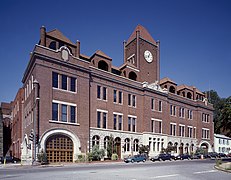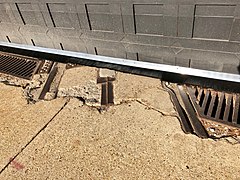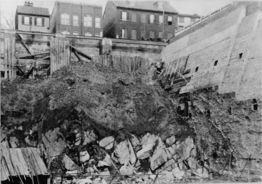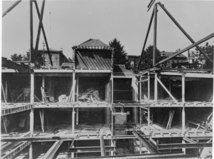Georgetown Car Barn
| Georgetown Car Barn | |
|---|---|
 M Street elevation in December 2018 | |
 | |
| Former names | Union Station |
| General information | |
| Architectural style | Romanesque Revival |
| Location | Georgetown, Washington, D.C., United States |
| Address | 3600 M Street, N.W. |
| Coordinates | 38°54′19″N 77°4′12″W / 38.90528°N 77.07000°WCoordinates: 38°54′19″N 77°4′12″W / 38.90528°N 77.07000°W |
| Current tenants | Georgetown University |
| Construction started | 1895 |
| Opened | May 27, 1897 |
| Height | |
| Architectural | 140 feet (43 m) |
| Technical details | |
| Floor count | 4 |
| Floor area | 81,765 square feet (7,596 m2) |
| Design and construction | |
| Architect | Waddy Butler Wood |
| Civil engineer | D.S. Carll |
Capital Traction Company Union Station | |
U.S. National Register of Historic Places | |
D.C. Inventory of Historic Sites | |
| Part of | Georgetown Historic District (ID67000025) |
| MPS | Streetcar and Bus Resources of Washington, DC MPS |
| NRHP reference No. | 100004248 |
| Significant dates | |
| Added to NRHP | August 9, 2019[2] |
| Designated NHLDCP | May 28, 1967 |
| Designated DCIHS | January 24, 2019[1] |
The Georgetown Car Barn, historically known as the Capital Traction Company Union Station, is a building in the Georgetown neighborhood of Washington, D.C., in the United States. Designed by the architect Waddy Butler Wood, it was built between 1895 and 1897 by the Capital Traction Company as a union terminal for several Washington and Virginia streetcar lines. The adjacent Exorcist steps, later named after their appearance in William Friedkin's 1973 horror film The Exorcist, were built during the initial construction to connect M Street with Prospect Street.
Intended for dual use as a passenger station and as a storage house for the streetcars, the Car Barn began Washington's only cable car system. Almost immediately after the building opened, the system was electrified, and the Car Barn was converted to accommodate electric streetcars. Throughout its history as a terminal and storage facility, the Car Barn was never utilized to the extent anticipated by its construction.
The building has undergone several renovations, the most extensive in 1911, when the original Romanesque Revival façade was significantly modified, and the interior was almost completely gutted. Not long after its opening, the building fell into disrepair. Changing ownership over time, it maintained its original function of housing streetcars until 1950, when it was redeveloped as office space. Among its occupants was the International Police Academy, an arm of the Central Intelligence Agency, which operated out of the Car Barn in the 1960s and 1970s. Today, it is used as an academic building by Georgetown University. In 2019, it was listed on the National Register of Historic Places.
History[]
Early history[]
In 1761, a tobacco warehouse was constructed at the Car Barn's site.[3] During the Civil War, the site became home to some of the city's horse-drawn streetcars.[4] On August 23, 1894, after the city's streetcars had begun to switch to electric power, Congress authorized an extension of the Washington and Georgetown Railroad to the intersection of 36th and M Streets, directly north of the north end of the Aqueduct Bridge.[5][6] The legislation required that the railroad erect at the site a union passenger station in order to accommodate the street railway traffic expected to converge at or near the bridge. The legislation limited the station's use to street railways only.[5]
Construction[]
Construction on the building then known as Union Station began in early 1895 under the architectural direction of Waddy Butler Wood.[7] The superintendent and chief engineer of the Capital Traction Company, D.S. Carll, was in charge of the construction.[8] Before the Car Barn's construction began, a steep hillside that 36th Street climbed stood between M and Prospect Streets.[6][9] Large amounts of earth were excavated—80,000 cubic yards (61,000 m3) in total—resulting in the sharp cliff that exists today. Adjacent to the Car Barn are a set of stairs commonly known as the "Exorcist steps" and a large retaining wall, which were built at the time the Car Barn was constructed, to connect M and Prospect Streets.[10] The steps are so named as they provided the location for the scene in the 1973 horror film The Exorcist where the priest is thrown down the stairs to his death.[11]
The next-door resident of the Prospect House, who furnished affidavits by prominent architects, opposed the building's construction by stating that blasting from the construction was damaging her house. This led to court-ordered supervision of the blasting in 1894.[12] After the Car Barn's construction, the large edifice obstructed the view of the Potomac River and Virginia from homes on Prospect Street, including the well-known cottage of E. D. E. N. Southworth.[a] For this reason, some considered it a "desecration" of the local scenery.[13]
The three-story, 180-by-242-foot (55 by 74 m) building was opened on May 27, 1897, containing offices for the several tenant trolley companies and waiting rooms that were decorated with red oak wainscot panelling, ornate iron stair railings, and stuccoed ceilings. The exterior was designed in the Romanesque Revival style.[14] The building's tower reached a height of 140 feet (43 m) and contained an elevator that shuttled passengers between the terminals.[7] Many of the building's decorations reflect its original function, including the pediment that faces M Street. The pediment, which contains the words "Capital Traction Company", displays three decorative flywheels of the type that pull cables.[15]
The M Street-facing first floor served the Washington and Georgetown Railroad. The Metropolitan Railroad used the roof, which had a covered walkway for passengers to travel between the street and the elevator.[7] Because of the lay of the land in the building's vicinity, other streetcars, including those serving the city's suburbs, would reach the building's second and third floors from steel trestles.[16]
Capital Traction expected trolleys to cross the Potomac River from Rosslyn on the nearby Aqueduct Bridge. At the time, those trolleys were traveling or would soon travel between downtown Washington, Arlington County (then named Alexandria County), Falls Church and the City of Alexandria.[15][17] Other trolleys were later expected to enter the building after traveling along the projected route of the Great Falls and Old Dominion Railroad.[15][18] The station operated as Washington's only cable car trolley terminal for less than a year.[7] Almost immediately after the building opened, Capital Traction converted it to enable the company to operate the new electric streetcars.[15] The Virginia lines never made use of the terminal. The Metropolitan Railroad originally intended to place storage tracks on the roof of the building, but never did.[7]
Re-design[]
Although regarded as well-designed before 1900, the Car Barn began a period of deterioration and neglect lasting for 50 years.[7] The first stage of the transition from a trolley station to an office building was carried out between 1906 and 1908 when portions of the second floor were converted into office space. The electrification of streetcars necessitated a large-scale re-design of the Barn, which began in 1910. The entrances to the building were extended to accommodate the larger cars, and a new elevator was installed to lift streetcars to the roof.[19] This transition required a near-complete reconstruction of the building. The steel support beams were replaced, and the entire façade was changed to extend toward M Street and increase its height to allow more office space. These modifications were complete in 1911.[20]
Further conversions of track space to office space occurred between 1921 and 1922. Extensive remodeling occurred again in 1933 with the designation of the Car Barn as the headquarters of the new Capital Transit Company, as a result of the merger between the Capital Traction Company and the Washington Railway and Electric Company, which increased the number of office workers at the building. These changes involved removing the roof in the center of the building, creating a lightwell on the third floor, converting the third floor into office space, and removing the covered passageway on the roof.[20]
Later uses[]
The last streetcar operations at the Car Barn ended with the closure of the Rosslyn–Benning Line on April 30, 1949. The building continued to store streetcars until May 1950. Toward the end of 1952, the first floor was converted into office space.[20]
When the Capital Transit Company merged with its competitors, the building came under the ownership of its new corporate successor, the DC Transit System, in 1956. By then, the building had fallen into such a state of disrepair that the company deliberated over whether to demolish it entirely. Seeking to preserve the historic structure, it elected to redevelop it.[7] The building underwent considerable interior renovations between 1957 and 1960, intended to turn the structure entirely into an office building. This involved lowering the ceilings, which were previously designed to accommodate the height of the streetcars.[20] The building was included in the Historic American Buildings Survey in 1967.[21]
Beginning in late 1963,[22] the Car Barn was home to the International Police Academy, operated by the Central Intelligence Agency (though officially part of the Agency for International Development) that trained Latin American police forces. Members of these forces met at the Car Barn until the program was shut down in 1975.[23] In 1992, the owner of the DC Transit System, O. Roy Chalk, was subject to foreclosure, and the building came under the ownership of the Lutheran Brotherhood.[24]
The Car Barn was purchased in 1997 by Douglas Development Corporation—which continues to own the building—and it was renovated the following year. The primary tenant is Georgetown University,[25] which first began leasing space in the 1950s.[26] After two years of renovation by the university that ended in 2017, the first floor garage was converted to house the Graduate School of Arts and Sciences and the Georgetown University Press.[27]
The building today has four floors and has a floor area of 81,765 square feet (7,596 m2).[25] Remnants of streetcar tracks and their central electrical conduit remain visible outside of the garage's east door on M Street.[28] The Car Barn was listed on the District of Columbia Inventory of Historic Sites on January 24, 2019.[1] The National Park Service added the building to the National Register of Historic Places as part of a multiple property submission named "Streetcar and Bus Resources of Washington, DC" on August 9, 2019.[2]

Prospect Street entrance in 1966

Prospect Street entrance in 2019

Streetcar tracks and conduit outside the garage's west door (1966)

View of Car Barn from the southwest between 1980 and 2006

Renovations had replaced the garage's west door with architectural glazing by December 2018.

View of Car Barn from the southeast between 1980 and 2006

Renovations had replaced the garage's east door with a new door by December 2018.

Streetcar tracks and conduit outside the garage's new east door (December 2018)
Notes[]
See also[]
- Wychwood Barns, a former streetcar barn and maintenance facility in Toronto converted into a community space
References[]
- ^ Jump up to: a b "HPRB Actions: January 24 and 31, 2019" (PDF). D.C. Historic Preservation Review Board. February 4, 2019. Retrieved October 30, 2019.
- ^ Jump up to: a b "National Register of Historic Places Program: Weekly List 20190906". National Park Service. September 6, 2019. Archived from the original on September 9, 2019. Retrieved September 10, 2019.
- ^ "The old Georgetown Car Barn, Washington, D.C." Library of Congress. Archived from the original on October 11, 2018. Retrieved October 11, 2018.
- ^ "DAVIS Leads Construction on Design-Build Project at Georgetown Car Barn". Washington Building Congress. July 17, 2014. Archived from the original on January 3, 2019. Retrieved January 3, 2019.
- ^ Jump up to: a b United States; District of Columbia. Board of Commissioners (1896). "AN ACT to amend an act entitled "An act to incorporate the Washington and Great Falls Electric Railway (August 23, 1894)". Laws relating to street-railway franchises in the District of Columbia: (Including street-railway laws enacted during the First session of the Fifty-fourth Congress). Washington, D.C.: Government Printing Office. pp. 198–199. OCLC 569582480. Retrieved July 15, 2021 – via HathiTrust Digital Library.
- ^ Jump up to: a b Thorn, C. W.; Baily, Thomas C. J., Jr., Civil Engineers. "Topographical map of Washington, D.C.: 1899-1900". Washington, D.C.: Globe Map & Atlas Company. LCCN 87694383. OCLC 16868694. Retrieved July 22, 2021 – via Library of Congress.
- ^ Jump up to: a b c d e f g "Our Projects: The Historic Car Barn". Douglas Development Corporation. Archived from the original on February 21, 2008. Retrieved October 11, 2018.
- ^ Commission of Fine Arts & Historical American Buildings Survey 1967, p. 22
- ^ Emmerson 2018, sec. 8, p. 10
- ^ Emmerson 2018, sec. 8, p. 9
- ^ "Spirits in Our Midst: In Georgetown, We Are Haunted by History". The Georgetowner. October 25, 2017. Archived from the original on October 11, 2018. Retrieved October 11, 2018.
- ^ Emmerson 2018, sec. 8, p. 12
- ^ Jump up to: a b "Why Do the Exorcist Steps Exist in the First Place?". The Georgetown Metropolitan. October 30, 2015. Archived from the original on September 28, 2018. Retrieved October 11, 2018.
- ^ MBA Student Handbook Of Guidelines and Requirements. Georgetown University McDonough School of Business. 2001. p. 47. CiteSeerX 10.1.1.202.51.
- ^ Jump up to: a b c d "One Last Remnant of Washington's Cable Cars Lives on in Georgetown". The Georgetown Metropolitan. September 16, 2011. Archived from the original on August 31, 2018. Retrieved October 11, 2018.
- ^ Historical American Buildings Survey, 1967, pp. 21–22.]
- ^ "Washington and Vicinity" (map). Washington, D.C.: United States Department of the Interior: United States Geological Survey. 1898. Retrieved July 24, 2020 – via University of Alabama Map Library.
- ^ Noetzel, Gregor (1907). "Map of Alexandria County, Virginia: formerly part of the District of Columbia" (map). Washington, D.C.: G.G. Boteler. LCCN 89692766. OCLC 20854717. Retrieved October 8, 2019 – via Library of Congress website.
- ^ Commission of Fine Arts & Historical American Buildings Survey 1967, p. 23
- ^ Jump up to: a b c d Commission of Fine Arts & Historical American Buildings Survey 1967, p. 24
- ^ Commission of Fine Arts & Historical American Buildings Survey 1967, p. 19
- ^ "Forgotten History of the Car Barn". Walsh School of Foreign Service. Archived from the original on May 2, 2019. Retrieved May 2, 2019.
- ^ Anderson, Jack (July 12, 1978). "Washington Merry-Go-Round: CIA trains Amin's henchmen". The Benton Courier. p. 14. Archived from the original on January 29, 2019. Retrieved January 29, 2019.
- ^ Fruehling, Douglas. "Jemal to Buy Georgetown's Car Barn". Douglas Development Corporation. Archived from the original on May 13, 2008. Retrieved January 2, 2019.
- ^ Jump up to: a b "The Car Barn". Douglas Development Corporation. Archived from the original on January 26, 2018. Retrieved October 11, 2018.
- ^ "Preserving the '60s – the 1760s – with Integrity". Davis Construction. Archived from the original on December 24, 2017. Retrieved January 3, 2019.
- ^ Wallender, Andrew (January 31, 2017). "University Completes Two-Year Renovation of Car Barn First Floor". The Hoya. Archived from the original on March 23, 2018. Retrieved October 11, 2018.
- ^ (1) "D.C. Transit". D.C. Streetcar Track and Structures. BelowTheCapital.org. Archived from the original on March 24, 2011.
Tracks can been seen in the concrete under the door.
(2) "Georgetown Car Barn door". D.C. Transit. BelowTheCapital.org. April 2, 2008. Archived from the original on June 21, 2017. Close-up photograph showing tracks and electrical conduit.
Sources[]
- Commission of Fine Arts; Historical American Buildings Survey (February 1967). "Capital Traction Company Union Station" (PDF). Historical American Buildings Survey Selections: Georgetown Commercial Architecture – M Street (Report). pp. 18–34. Archived from the original (PDF) on July 18, 2017. Retrieved November 22, 2018.
- Emmerson, Catherine (September 25, 2018). Application for Historic Landmark or Historic District Designation: Georgetown Retaining Wall/Exorcist Steps (PDF) (Report). District of Columbia Historic Preservation Review Board. Archived (PDF) from the original on January 29, 2019. Retrieved January 29, 2019.
External links[]
| Wikimedia Commons has media related to Georgetown Car Barn. |
- Historic district contributing properties
- 1895 establishments in Washington, D.C.
- Brick buildings and structures
- Industrial buildings completed in 1897
- Office buildings completed in 1897
- Industrial buildings and structures in Washington, D.C.
- Office buildings in Washington, D.C.
- Railway stations in the United States opened in 1897
- Georgetown (Washington, D.C.)
- Georgetown University buildings
- Streetcars in Washington, D.C.
- Tram stops
- Romanesque Revival architecture in Washington, D.C.
- Clock towers in the United States
- Railway buildings and structures on the National Register of Historic Places in Washington, D.C.
- District of Columbia Inventory of Historic Sites
- Historic American Buildings Survey in Washington, D.C.














